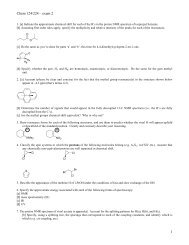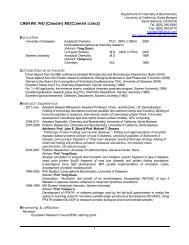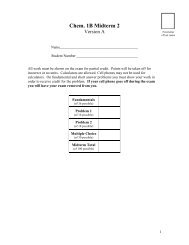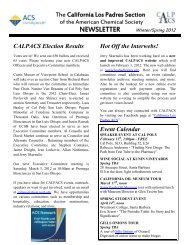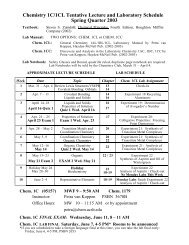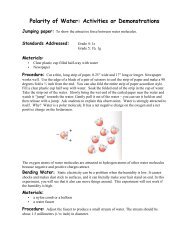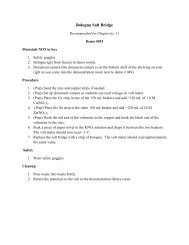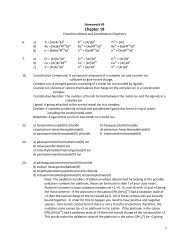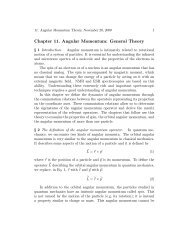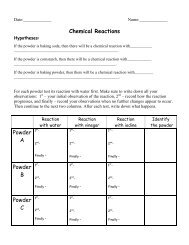CHEM 2A – FINAL EXAM 1
CHEM 2A – FINAL EXAM 1
CHEM 2A – FINAL EXAM 1
You also want an ePaper? Increase the reach of your titles
YUMPU automatically turns print PDFs into web optimized ePapers that Google loves.
<strong>CHEM</strong> <strong>2A</strong> <strong>–</strong> <strong>FINAL</strong> <strong>EXAM</strong><br />
First letter of your last name<br />
NAME:___________________________<br />
PERM#____________________<br />
INSTRUCTIONS: Fill in your name, perm number and first initial of your last name above. Be sure to<br />
show all of your work for full credit. Use the back of the page if necessary.<br />
Useful information (periodic table, equations, constants etc..) is at the end of the test packet. You may<br />
tear them off for easy reference.<br />
1
<strong>CHEM</strong> <strong>2A</strong> <strong>–</strong> <strong>FINAL</strong> <strong>EXAM</strong><br />
SCORE: ________ 200 pts possible<br />
PART I <strong>–</strong> SHORT RESPONSE / MULTIPLE CHOICE<br />
1. (12 pts) Consider the following generalized reaction and answer the following<br />
questions.<br />
forward<br />
( g )<br />
2<br />
( g) 2<br />
reverse ( l)<br />
A + B C<br />
A) When the above system is at equilibrium which of the following statements is true<br />
concerning the reaction rates<br />
a) The forward rate of reaction is faster than the reverse rate of reaction<br />
b) The reverse rate of reaction is faster than the forward rate of reaction<br />
c) The forward rate of reaction is equal to the reverse rate of reaction<br />
d) There is not enough information to answer the question<br />
B) If additional component B is added to the system at equilibrium which of the<br />
following statements is true regarding the reaction quotient Q before equilibrium is<br />
reestablished<br />
a) The value of Q is greater then K<br />
b) The value of Q is less than K<br />
c) The value of Q is the same as K<br />
c) There is not enough information to answer the question<br />
C) If the pressure of the system is decreased by increasing the volume of the container<br />
which of the following statements is true<br />
a) The reaction shifts to the right<br />
b) The reaction shifts to the left<br />
c) There is no change<br />
d) There is not enough information to answer the question<br />
2. (10 pts) Write the molecular formulas for the following compounds<br />
A) Sodium acetate ___________________<br />
B) Potassium dihydrogen phosphate ___________________<br />
C) Ammonium sulfate ___________________<br />
D) Ferric oxide ___________________<br />
E) Zinc sulfide ___________________<br />
2
<strong>CHEM</strong> <strong>2A</strong> <strong>–</strong> <strong>FINAL</strong> <strong>EXAM</strong><br />
3. (10 pts) Will the following solutions be acidic, basic or neutral<br />
A) 0.10 M ammonium chloride _________________<br />
B) 0.05 M calcium bromide _________________<br />
C) 0.32 M citric Acid _________________<br />
D) 0.87 M pyridine _________________<br />
E) 0.1 M sodium acetate, 0.1 M acetic acid _________________<br />
4. (6 pts) The sodium salt of a weak acid, NaA, is dissolved in water. No other substance<br />
is added. Which of the following statements is true<br />
A) [H + ] = [A - ]<br />
B) [H + ] = [OH - ]<br />
C) [OH - ] = [A - ]<br />
D) [HA] = [OH - ]<br />
E) none of the above<br />
5. (6 pts) Which of the following is true. The value of the equilibrium constant, K, is<br />
dependent on<br />
I. The temperature of the system<br />
II. The nature of the reactants and products<br />
III. The concentration of reactants<br />
IV. The concentration of products<br />
A) I and II<br />
B) III and IV<br />
C) II and III<br />
D) II, III and IV<br />
E) None of the above<br />
3
<strong>CHEM</strong> <strong>2A</strong> <strong>–</strong> <strong>FINAL</strong> <strong>EXAM</strong><br />
6. (6 pts) Which of the following solutions would be the best system if a buffer near pH<br />
3.7 was desired<br />
A) 0.1 M acetic acid, 0.1 M acetate<br />
B) 0.1 M benzoic acid, 0.1 M benzoate<br />
C) 0.1 M formic acid, 0.1 M formate<br />
D) 0.1 M hydrofluoric acid, 0.1 M fluoride<br />
E) 0.1 M nitrous acid, 0.1 M nitrite<br />
7. (8 pts) Write each answer with the correct number of significant figures<br />
A) 1.021 + 2.69 =<br />
B) 12.3 - 1.63 =<br />
C) 4.34 × 9.2 =<br />
D) 0.0602 ÷ (2.113 × 10 -4 ) =<br />
PART II <strong>–</strong> CALCULATIONS<br />
8. (12 pts) A 1.621 gram sample of an unknown organic compound containing C,H and O<br />
only was combusted in the presence of an excess of oxygen gas. Analysis of the products<br />
revealed that 1.902 grams of water and 3.095 grams of carbon dioxide were produced.<br />
What is the empirical formula of the compound<br />
4
<strong>CHEM</strong> <strong>2A</strong> <strong>–</strong> <strong>FINAL</strong> <strong>EXAM</strong><br />
9. (10 pts) Calculate the volume of carbon dioxide at 25 o C and 1 atm needed for a plant<br />
to photosynthesize 1.0 gram of glucose, C 6 H 12 O 6 , by the following reaction:<br />
6CO + 6H O → C H O + 6O g<br />
2( g ) 2 ( l) 6 12 6( s) 2( )<br />
10. (12 pts) Balance the following redox reaction of oxalic acid and permanganate ion in<br />
acidic solution.<br />
HCO + MnO → CO + Mn<br />
− 2+<br />
2 2 4( aq) 4( aq) 2( g ) ( aq)<br />
5
<strong>CHEM</strong> <strong>2A</strong> <strong>–</strong> <strong>FINAL</strong> <strong>EXAM</strong><br />
11. (16 pts) Nitrogen gas, N 2 reacts with hydrogen gas, H 2 to form ammonia gas, NH 3 in<br />
the presence of a proper catalyst. The following apparatus is constructed in a lab with<br />
room temperature of 23 o C.<br />
Flask A contains 1.25 L of nitrogen gas at a pressure of 1.1 atm. Flask B contains 3.5 L<br />
of hydrogen at a pressure of 0.75 atm.<br />
A) Write the balanced chemical equation for the reaction of hydrogen and nitrogen to<br />
form ammonia.<br />
B) Calculate the total pressure in the apparatus when the stopcock is opened and before<br />
any reaction occurs (assume the stopcock has no volume).<br />
C) How many moles of ammonia are formed<br />
D) Calculate the partial pressures of all the gasses remaining after the reaction has gone<br />
to completion.<br />
6
<strong>CHEM</strong> <strong>2A</strong> <strong>–</strong> <strong>FINAL</strong> <strong>EXAM</strong><br />
12. (12 pts) Calcium carbide, CaC 2 , reacts with water to form calcium hydroxide and the<br />
flammable gas acetylene, C 2 H 2 . This reaction was once used for lamps on bicycles and<br />
miner’s hats because the reactants are easy to transport. The chemical equation is:<br />
CaC + 2 H O → Ca( OH ) + C H<br />
g<br />
2( s) 2 ( l) 2( aq) 2 2( )<br />
A) What is the limiting reagent if 100 grams of water are reacted with 100 grams of<br />
calcium carbide<br />
B) What mass of acetylene is produced<br />
C) What mass of the excess reactant remains after the reaction is complete<br />
13. (10 pts) Mass spectrometry analysis of copper metal reveals that 69.09% of the<br />
sample is 63 Cu (62.93 amu/atom) the only other isotope in this sample was 65 Cu. Using<br />
the atomic mass of copper (63.55 g/mole) determine the mass of 65 Cu in amu.<br />
Note: 1 gram = 6.022 × 10 23 amu.<br />
7
<strong>CHEM</strong> <strong>2A</strong> <strong>–</strong> <strong>FINAL</strong> <strong>EXAM</strong><br />
14. (12pts) Calculate the pH of 50 mL of a 0.10 M HF solution that has been titrated with<br />
15 mL of 0.25 M KOH.<br />
15. (12 pts)The K sp for PbI 2 in water is 1.4 × 10 -8 . What is the concentration of Pb 2+ in a<br />
saturated solution of PbI 2 <br />
8
<strong>CHEM</strong> <strong>2A</strong> <strong>–</strong> <strong>FINAL</strong> <strong>EXAM</strong><br />
16. (20 pts) Consider the titration of 50 mL of 0.05 M malonic acid with 0.1 M KOH.<br />
The titration curve is shown below.<br />
A) Label the first and second equivalence points on the plot above<br />
B) How many mL of KOH must be added to result in a solution with a pH of 2.82<br />
C) Calculate the pH of the solution when 45 mL of KOH have been added<br />
9
<strong>CHEM</strong> <strong>2A</strong> <strong>–</strong> <strong>FINAL</strong> <strong>EXAM</strong><br />
17. (14 pts) Ferric hydroxide, Fe(OH) 3 is minutely soluble in water (K sp = 4 × 10 -38 ).<br />
What is the concentration of Fe 3+ in a pH 5.0 buffer solution that is saturated with<br />
Fe(OH) 3 <br />
18. (12 pts) A 1.4922 ± 0.0002 gram sample of silver ore was digested in acid and the<br />
silver was precipitated as silver chloride, AgCl. The solid silver chloride weighed<br />
0.0892 ± .0002 grams. Calculate the mass percent of silver in the ore. Report your result<br />
with the correct significant figures and absolute error.<br />
10
<strong>CHEM</strong> <strong>2A</strong> <strong>–</strong> <strong>FINAL</strong> <strong>EXAM</strong><br />
11
<strong>CHEM</strong> <strong>2A</strong> <strong>–</strong> <strong>FINAL</strong> <strong>EXAM</strong><br />
Equations<br />
x =<br />
∑<br />
[ X ]<br />
i<br />
[ ] + [ ]<br />
f<br />
i<br />
n<br />
f<br />
x<br />
I<br />
X<br />
=<br />
S X I +<br />
i<br />
X<br />
S<br />
s =<br />
∑<br />
i<br />
( x<br />
i<br />
− x)<br />
n −1<br />
[ X] = [ X]<br />
f<br />
[ S] = [ S]<br />
f<br />
i<br />
i<br />
2<br />
( V0<br />
)<br />
( V )<br />
( VS<br />
)<br />
( V )<br />
N<br />
0<br />
μ =<br />
x ±<br />
ts<br />
n<br />
= 6.02214×<br />
10<br />
23<br />
−27<br />
amu = 1.66054×<br />
10 kg<br />
R<br />
R<br />
X S<br />
2 2<br />
= F<br />
e= [ X ] [ S]<br />
( e1) + ( e2) + ( e3)<br />
% % % % ...<br />
2 e= e 2 + e 2 + e 2<br />
...<br />
1 2 3<br />
N<br />
0<br />
= 6.02214×<br />
10<br />
23<br />
−27<br />
amu = 1.66054×<br />
10 kg<br />
PV<br />
= nRT<br />
kB<br />
= 1.38066×<br />
10<br />
JK<br />
−23 −1<br />
R = 0.08206 Latmmol K<br />
R=<br />
8.31451 J mol K<br />
−1 −1<br />
−1 −1<br />
P = P + P + P +⋅⋅⋅<br />
Total<br />
P = χ × P<br />
1 1<br />
1 2 3<br />
aA + bB cC + dD<br />
3RT<br />
2RT<br />
8RT<br />
u = rms<br />
; ump ; uavg<br />
M = M = π M<br />
[ ] c<br />
[ ] d<br />
C D<br />
K =<br />
a b<br />
[ A] [ B]<br />
2<br />
⎡ ⎛ n ⎞ ⎤<br />
⎢Pobs<br />
+ a⎜<br />
⎟ ⎥( V − nb)<br />
= nR<br />
⎢⎣<br />
⎝V<br />
⎠ ⎥⎦<br />
Total<br />
pH + pOH = pK<br />
w<br />
T<br />
14<br />
Kw<br />
= [ H + ][ OH<br />
− ] = 1×<br />
10<br />
−<br />
Kp<br />
n<br />
χ<br />
1<br />
=<br />
n<br />
1<br />
Total<br />
= K( RT) Δn<br />
pK + pK = pK<br />
a b w<br />
( conjugate pairs)<br />
1 torr = 1 mmHg 760 mm Hg = 1 atm<br />
12
<strong>CHEM</strong> <strong>2A</strong> <strong>–</strong> <strong>FINAL</strong> <strong>EXAM</strong><br />
Acid Dissociation Constants (25 o C)<br />
Name Formula K a1 K a2 K a3<br />
Acetic HC 2 H 3 O 2 1.8 × 10 -5<br />
Ammonium ion<br />
+<br />
NH 4 5.6 × 10 -10<br />
Arsenic H 3 AsO 4 5.6 × 10 -3 1.0 × 10 -7 3.9 × 10 -12<br />
Ascorbic HC 6 H 7 O 6 8.0 × 10 -5 1.6 × 10 -12<br />
Benzoic HC 7 H 5 O 2 6.5 × 10 -5<br />
Boric H 3 BO 3 5.8 × 10 -10<br />
Carbonic H 2 CO 3 4.3 × 10 -7 4.8 × 10 -11<br />
Chloroacetic HC 2 H 2 O 2 Cl 1.4 × 10 -3<br />
Citric H 3 C 6 H 5 O 7 7.4 × 10 -4 1.7 × 10 -5 4.1 × 10 -7<br />
Formic HCHO 2 1.8 × 10 -4<br />
Hydrocyanic HCN 4.9 × 10 -10<br />
Hydrofluoric HF 7.2 × 10 -4<br />
Hydrogen selenate ion<br />
-<br />
HSeO 4 2.2 × 10 -2<br />
Hydrogen sulfide H 2 S 9.1 × 10 -8 1.1 × 10 -12<br />
Hypobromous HBrO 2.1 × 10 -9<br />
Hypochlorous HClO 3.0 × 10 -8<br />
Hypoiodous HIO 2.3 × 10 -11<br />
Iodic HIO 3 1.7 × 10 -1<br />
Lactic HC 3 H 5 O 3 1.4 × 10 -4<br />
Malonic H 2 C 3 H 2 O 4 1.5 × 10 -3 2.0 × 10 -6<br />
Nitrous HNO 2 4.5 × 10 -4<br />
Oxalic H 2 C 2 O 4 5.9 × 10 -2 6.4 × 10 -5<br />
Phenol HC 6 H 5 O 1.3 × 10 -10<br />
Phosphoric H 3 PO 4 7.5 × 10 -3 6.2 × 10 -8 4.2 × 10 -13<br />
Propionic HC 3 H 5 O 2 1.3 × 10 -5<br />
Pyrophosphoric H 4 P 2 O 7 3.0 × 10 -2 4.4 × 10 -3<br />
Selenous H 2 SeO 3 2.3 × 10 -3 5.3 × 10 -9<br />
Sulfuric H 2 SO 4 Strong Acid 1.2 × 10 -2<br />
Sulfurous H 2 SO 3 1.7 × 10 -2 6.4 × 10 -8<br />
Tartaric H 2 C 4 H 4 O 6 1.0 × 10 -3 4.6 × 10 -5<br />
Base Dissociation Constants (25 o C)<br />
Name Formula K b<br />
Ammonia NH 3 1.8 × 10 -5<br />
Aniline C 6 H 5 NH 2 4.3 × 10 -10<br />
Dimethlyamine (CH 3 ) 2 NH 5.4 × 10 -4<br />
Ethylamine C 2 H 5 NH 2 6.4 × 10 -4<br />
Hydrazine H 2 NNH 2 1.3 × 10 -6<br />
Hydroxylamine HONH 2 1.1 × 10 -8<br />
Methylamine CH 3 NH 2 4.4 × 10 -4<br />
Pyridine C 5 H 5 N 1.7 × 10 -9<br />
Trimethylamine (CH 3 )CN 6.4 × 10 -5 13




